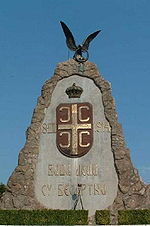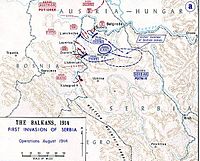- Battle of Cer
-
Battle of Cer Part of the Serbian Campaign of the Balkans Theatre (World War I)
Monument to fallen heroes of the Battle of CerDate 16 August to 19 August 1914 Location Near Cer and the village of Tekeriš Result Decisive Serbian Victory[1] Belligerents  Austria-Hungary
Austria-Hungary Serbia
SerbiaCommanders and leaders Oskar Potiorek
Liborius Ritter von FrankStepa Stepanović
Pavle Jurišić ŠturmStrength 200,000 180,000 Casualties and losses 18,500 killed or wounded
4,500 captured4,785 killed or missing
11,215 wounded- Cer
- Drina
- Kolubara
- Morava
- Ovche Pole
- Kosovo
- Mojkovac
The Battle of Cer also known as Battle of Jadar (the main operations were held near the river basin of the Jadar river in Serbia) was one of the first battles of World War I, it also marked the first Allied victory in the war.[2] The battle was fought between the Austro-Hungarian Army and Serbian forces. The results improved Serbian standing in the Alliance. Austro-Hungarian troops fought under the command of Generals Oskar Potiorek and Liborius Ritter von Frank. Von Frank was in direct command of the Austro-Hungarian 5th Army at Cer. Most of the Serbian troops were under the command of General Stepa Stepanović.
Contents
Battle summary
Order of Battle
Austrian push
In the opening stages of the First World War, the Austro-Hungarian Army Group Balkans, under the command of General Oskar Potiorek, pushed into northwestern Serbia across the Sava and Drina rivers. The city of Šabac fell. Following the expansion of bridgeheads, most elements of the 2nd and 5th armies successfully crossed into Serbia by 12 August. Potiorek's own 6th army was still concentrating further south and was in no position to begin a large operation at this time, so the brunt of the fighting in the following days was on the 5th Army. According to Potjorek's plan, it was to attack in the general direction of Valjevo immediately after the crossing and take the city in five days.
Serbian response
Reports of the Austrian incursion reached the Serbian staff during the day. It was clear that a major operation had begun, but Field Marshal Putnik still had not completely abandoned his view that the main Austrian thrust would come from the north, concentrated on the Morava river valley. It took some time until his assistants, general Mišić, and head of Operations, colonel Živko Pavlović convinced him to take decisive action.
Along with the direct military pressure of Austria-Hungary, Serbia was pressed to take an offensive stance by its Allies, at the time waging difficult battles in northwestern Europe. The Serbian Staff replied that its units were already on the offensive against the Austrian bridgeheads. The Serbian Second Army, under the command of General Stepanović advanced towards Cer, the Šumadija Division towards Šabac and the Cavalry Division towards Mačva. On the left flank, the Third Army, under the command of General Pavle Jurišić Šturm, entered the battle. Then the 3rd launched a massive offensive push through the Austrian lines, crushing the bulk of them.
The Serbian Second Army was, due to its position in the center of the northwestern cordon formation, the strongest of the three armies, not in term of numbers but of the quality of its divisions (the largest was the First Army, which was assigned to protect the entrance to the Morava river valley. This being the best possible approach to Serbia due to the lack of natural defenses, unlike the mountainous northeast and northwest). It consisted only of the divisions of the first call up (prvi poziv), of soldiers in their 20's and with the best training and materials available. These were the Šumadijska, Moravska, Dunavska (which, being responsible for the defence of Belgrade, had additional regiments attached to them) and Kombinovana (combined) divisions. This organizational structure was chosen by Field Marshal Putnik not just to have a strong center, but also, due to their central position, the Second Army's divisions could at any time be attached to either the First or Third army if the strategic development dictated such an action. Hence, when there was no longer any doubt about the direction of the Austro-Hungarian invasion, the Serbian cordon conducted a regrouping (movement of app. 90 degrees counterclockwise) of all of its armies and the Second Army faced von Franck's Fifth Army (the only Austro-Hungarian field army which had crossed into Serbia in full strength) at Cer and Jadar valley.
Battle
During August 1914 a battle was waged in the area of Mt. Cer, in which around 200,000 Austro-Hungarians fought against 180,000 Serbs. The main battle at Cer lasted from August 16 to August 19. The Serbian Army was victorious, pushed the Austro-Hungarian Army back across the Drina river, and completely thwarted their war plan. Following the crossing of the Drina river by the units of the Austrian 5th Army, it's units were persistently harassed by the irregulars of the Jadar Chetnik Detachment, which slowed down their advance. This, along with the persistent defense of the Serbian 3rd Army allowed the divisions of the 2nd Army to take control of the ridges of mount Cer, which proved decisive during the course of the three day battle.
Outcome
Around 18,500 Austro-Hungarian officers and soldiers were killed or wounded and around 6,500 were captured. The Serbian Army lost around 4,785 and 250 officers. As a result of the battle Austria-Hungary withdrew from Sandžak, delaying their offensive into Serbia. Austria-Hungary continued offensives into Serbia for the rest of the autumn of 1914 without much success. Cer also gave the Entente their first victory of the war against the Central Powers.
Discussion
Another thing of great importance during the Cer battle was Putnik's unwillingness to conduct aggressive offensive maneuvers (this was also the case in the First Balkan War) due to his fear of unnecessary risk which could lead to higher casualties in the already undermanned Serbian army. An example was when he overruled General Stepanović's proposal on the eve of the third day of the battle. Stepanović sensed that Austro-Hungarian forces on Cer and Everk were beginning to crumble, so he suggested a bold maneuver in which his Kombinovana and Moravska divisions would conduct a forced frontal pursuit of opposing troops on Cer and Everk ridges, whilst the Cavalry and Timočka (this division was hardly used during the entire course of the battle, to significant disadvantage regarding the outcome) divisions would conduct a parallel pursuit on the northern slope of Cer towards Lešnica, with orders to attack both the enemy's flanks and to reach the pontoon bridges on the Drina river and therefore cut the Fifth Army's main line of retreat. If this maneuver had been conducted, the possibility of a more catastrophic defeat of the Austro-Hungarian forces was significant. Yet, Putnik ordered Stepa to pursue the enemy forces frontally and not to conduct any sort of flanking attack, which would, in itself, cause far larger casualties upon the retreating enemy. The Third Army's loss of contact with the enemy on the third day of the battle also helped the Austro-Hungarian Fifth Army to withdraw in a more orderly fashion. Considering this, it is probable that the invading force could have suffered a far costlier defeat had Putnik allowed more independence to his field commanders instead of his attempt to micromanage operations. A reason for this may lie in his early command experiences in the wars with Turkey and Bulgaria, where some exceedingly ambitious plans led to disasters in the field.
Legacy
Historical artifacts can be found in a museum located in the city of Šabac.
Notes
- ^ Burg, David F. and L. Edward Purcell, Almanac of World War I, (University Press of Kentucky, 1998), 17.
- ^ Tucker, Spencer C; Roberts, Priscilla Mary (2005), Encyclopedia of World War I, p.172 Santa Barbara: ABC-Clio, ISBN 1851094202, OCLC 61247250
References
- Skoko, Savo Vojvoda Radomir Putnik. Beogradski grafičko-izdavački zavod. 1984.
- http://www.austro-hungarian-army.co.uk/serbia.htm
Categories:- Conflicts in 1914
- 1914 in Serbia
- Battles of World War I involving Serbia
- Battles of World War I involving Austria-Hungary
- Battles of the Balkans Theatre (World War I)
- Battles involving Serbia
Wikimedia Foundation. 2010.


